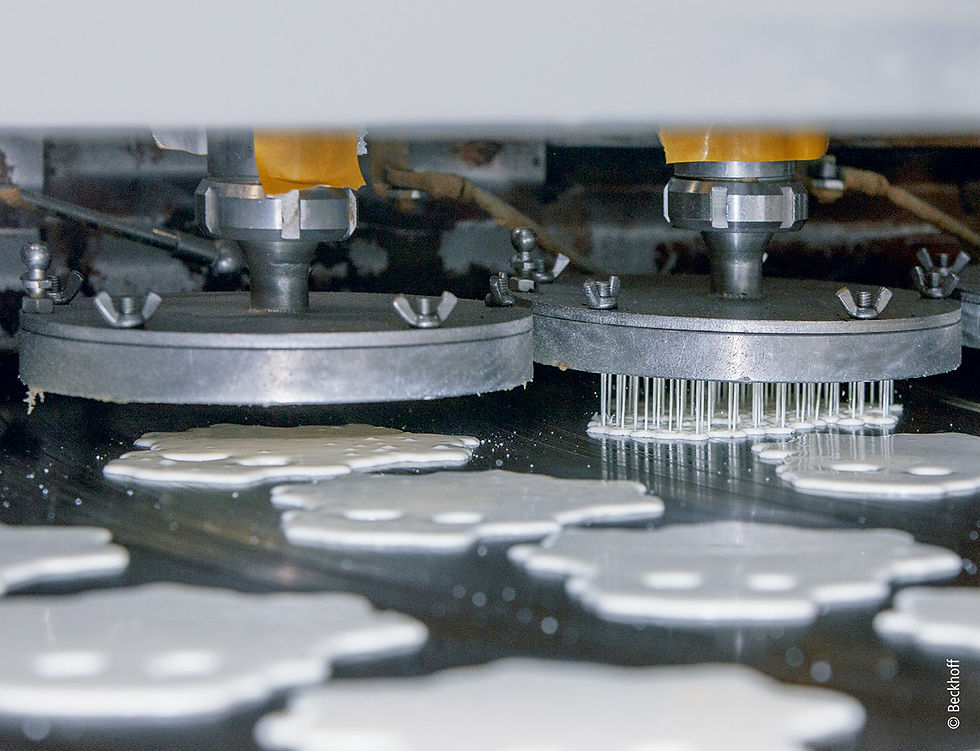Recipe for Success: PC Control Powers Digitalization at Pancake Plant
- Mark Ruberg

- Sep 8, 2023
- 5 min read
Using the latest automation technology, CTRL Engineering cooked up innovative kitchen-to-cloud solutions for Yummy Bakery, reducing material waste by up to 8%
Annie Alderweireldt’s world didn't always revolve around pancakes. She had a normal life in Bruge, Belgium, waking up and going to work. But that changed in 1984. When she became pregnant and couldn’t work, she found a new outlet – creating the perfect traditional pancake – not knowing they would change everything for her and her family.
“She started experimenting in the kitchen until she had the recipe for the perfect pancake, using her neighbors as taste testers,” says Alderweireldt’s daughter, Sara Geldhof. “She then went to the local bakers and butchers in Dudzele, near Bruges, to market her pancakes.”

Alderweireldt’s efforts snowballed. Soon, her pancakes were on convenience store shelves, and big supermarket chains started calling her. That’s how Yummy Bakery was born.
“Mom’s arm pouring the dough onto the baking plate over and over again in the same fluid motion with a ladle – that was actually our first ‘machine.’ But at some point that was no longer feasible. So we built a carousel that worked semi-automatically at least,” recalls Geldhof, who now runs the company with her brother, Tom Geldhof.
Yummy Bakery's pancakes remain a “hot” commodity in Belgium. You can find them on the shelves of virtually every major retail chain in the country. What’s the secret ingredient for this long-term success? The company uses authentic ingredients and still prepares the confections on a baking plate.
This recipe pairs perfectly with digitalization, as CTRL Engineering successfully demonstrated. On top of a 7-8% reduction in raw material, the automation of dough dosing with control technology from Beckhoff also helped provide data for ongoing process optimizations.
The proof is in the pancake
In 1995, Yummy Bakery built a production facility in an industrial park in Bruges. When implementing its first industrial pancake machine, the family continued to prize authenticity, as Sara Geldhof explains: "We achieved the typical taste by opting to prepare via griddle. Compared to using infrared technology, this method sears the pancake immediately, so the dough inside stays soft and creamy. In addition, only natural ingredients enter the recipe, no preservatives or colorings, just pure nature.”

With a second production facility, Yummy Bakery increased its capacity from 10,000 to 22,500 pancakes per hour. The product line keeps growing, without straying from the authentic philosophy, to include organic pancakes and products in spooky shapes for Halloween. And like a stack of flapjacks, the company’s growth curve continues to get higher and higher: last year alone, sales increased 25%.
“We couldn’t ignore automation and digitalization anymore if we wanted to keep up with our growth,” Geldhof says. “We are all about fresh products, so everything we produce goes straight out the door. In the past, you could manage that with a good team that had all the necessary know-how in their heads. Today, though, you have to secure that knowledge using technology. The goal is to create a complete digital flow that improves our process stability and minimizes repetitive work for our employees.”
To achieve this, Yummy Bakery partnered with CTRL Engineering, based in Oostende, Belgium. The machine builder’s background in automotive surprisingly applied to the pancake production systems, according to Pieter Meseure, Managing Director of CTRL Engineering.
“In automotive production lines, the goal is zero errors. Because profit margins are tight, the entire process is completely purged of inaccuracies. We want to introduce these principles to other sectors as well. Together we look for ways to improve our customers' processes and produce more with the same machines and people. What we offer is efficiency as a service.”
Automation upgrades serve up serious ROI

Although Yummy Bakery and CTRL Engineering both wanted to set the bar high, they decided to start small. “We started looking for the low-hanging fruit. Something that would give us immediate profit, so that we had more resources to take the next steps in digitalization,” Meseure says.
First, they targeted inconsistent pancake weights, explains Mathieu Dutré, Director of Innovation and Business Development at CTRL Engineering: "We were wondering, if we can save 10% overweight, what impact would that have on the bottom line? A calculation pointed to an ROI of less than a year. That was a no-brainer!"

Until then, dosing had been done pneumatically. Depending on the recipe, operators would have to adjust the compressed air flow rate manually. As a result, a pack of pancakes with a nominal weight of 500 g could weigh between 500 g and 560 g. CTRL Engineering used virtual engineering to see how they could best address the problem and what hardware would suit the specifications. The first step was introducing pressure control on the machine’s four nozzles.
“Now it is calculated as a function of a motor's torque,” Meseure says. “To achieve the proposed weight savings, the settings need to be continuously improved. So we created a closed control loop using the servomotor as a virtual sensor. In addition, we process input from a scale that is used to monitor the average and trend in the pancakes’ weight to detect deviations. The data from a checkweigher located at the end of the packaging line is also integrated into the model. After all, the cooling tower the pancakes have to pass first also has an impact on the weight.”
Hunger for continuous improvement
All measured data converge on a cloud platform that CTRL Engineering developed. Here, the results are clear. The pancakes’ weights now deviate by only 0.4 g, which corresponds to a 7-8% reduction in raw materials waste. “And we are also already seeing how we can get to a 0.1 g deviation over time,” Dutré adds.
The savings are simple, and so is the machine operation. Operators only need to click on the right recipe. But in the background, complex algorithms and models calculate a digital twin of the physical machine.

“For this, integration of data is key, which is why the backbone of our solution consists of Beckhoff control technology. Their PC-based control platform allows you to add functionalities through software, without having to change the hardware,” Dutré says.
The openness of Beckhoff technology is another major asset, according to Meseure. “In TwinCAT, we can seamlessly link all kinds of systems and data, allowing us to respond quickly to changes,” he says.
On the shop floor, a Beckhoff CX5240 Industrial PC serves as controller, and a CP3916 Control Panel provides a sleek operator interface. “In stainless steel execution, the CP3916 is perfect for application in the food industry,” says Dutré. “Not only does the Beckhoff technology do everything it is supposed to do on the shop floor, but also there is a knowledgeable team behind it that is always available.”
In terms of digitalization, this is just the first batch of enhancements to come off the griddle. Like Alderweireldt striving for that perfect recipe in 1984, Yummy Bakery and CTRL Engineering will keep working to go from better to best. The next order is automating quality inspection at the end of the packaging line by adding image processing capabilities via TwinCAT Vision.
“We are just waiting for the introduction of OCR functionality. Behind the scenes, Beckhoff is already training a machine learning model to recognize even more fonts,” Meseure says. “The potential profits from that should serve to eventually install a second production line in the new building, adding another 50% of capacity. Then we can transfer all production facilities from the first building to this one and repeat the process until we achieve one perfect, digital flow.”
Ready to cook up a delicious new automation solution for your food processing and packaging challenges? Contact your local Beckhoff sales engineer today.

Mark Ruberg is the Packaging Industry Manager for Beckhoff Automation LLC



Comments